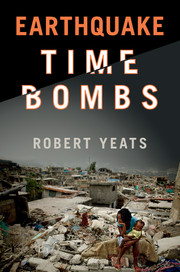Book contents
- Frontmatter
- Contents
- Acknowledgments
- Why this book?
- PART I EARTHQUAKES, DEEP TIME, AND THE POPULATION EXPLOSION
- PART II EARTHQUAKE TIME BOMBS
- TIME BOMBS WHERE THE PROBLEM IS UNDERSTOOD, BUT THE RESPONSE IS STILL INADEQUATE
- OTHER TIME BOMBS, INCLUDING CITIES THAT ARE NOT WELL PREPARED
- 13 Age of Enlightenment and the 1755 Lisbon earthquake
- 14 Jerusalem: earthquakes in the Holy Land
- 15 Istanbul: responding to an official earthquake warning
- 16 Tehran: the next earthquake in the Islamic Republic of Iran?
- 17 Kabul: decades of war and Babur's warning
- 18 Earthquakes in the Himalaya
- 19 Myanmar and the Sagaing fault
- 20 Metro Manila, the Philippines
- 21 Lima, Peru: Inca earthquake-resistant construction and a bogus American earthquake prediction
- 22 Andean earthquakes in Quito and Guayaquil, Ecuador
- 23 Caracas: lots of oil, but little interest in earthquakes
- 24 Haiti, which lost its gamble, and Jamaica and Cuba (not yet)
- 25 Mexico City: bowl of jello inherited from the Aztecs
- 26 Central America and the earthquake that brought down a dictator
- 27 East African Rift Valley: a tale of two cities
- PART III SUMMARY AND RECOMMENDATIONS
- References
- Index
26 - Central America and the earthquake that brought down a dictator
from OTHER TIME BOMBS, INCLUDING CITIES THAT ARE NOT WELL PREPARED
Published online by Cambridge University Press: 05 November 2015
- Frontmatter
- Contents
- Acknowledgments
- Why this book?
- PART I EARTHQUAKES, DEEP TIME, AND THE POPULATION EXPLOSION
- PART II EARTHQUAKE TIME BOMBS
- TIME BOMBS WHERE THE PROBLEM IS UNDERSTOOD, BUT THE RESPONSE IS STILL INADEQUATE
- OTHER TIME BOMBS, INCLUDING CITIES THAT ARE NOT WELL PREPARED
- 13 Age of Enlightenment and the 1755 Lisbon earthquake
- 14 Jerusalem: earthquakes in the Holy Land
- 15 Istanbul: responding to an official earthquake warning
- 16 Tehran: the next earthquake in the Islamic Republic of Iran?
- 17 Kabul: decades of war and Babur's warning
- 18 Earthquakes in the Himalaya
- 19 Myanmar and the Sagaing fault
- 20 Metro Manila, the Philippines
- 21 Lima, Peru: Inca earthquake-resistant construction and a bogus American earthquake prediction
- 22 Andean earthquakes in Quito and Guayaquil, Ecuador
- 23 Caracas: lots of oil, but little interest in earthquakes
- 24 Haiti, which lost its gamble, and Jamaica and Cuba (not yet)
- 25 Mexico City: bowl of jello inherited from the Aztecs
- 26 Central America and the earthquake that brought down a dictator
- 27 East African Rift Valley: a tale of two cities
- PART III SUMMARY AND RECOMMENDATIONS
- References
- Index
Summary
INTRODUCTION
Central America consists of seven small countries between Mexico and Colombia, most of which are afflicted by earthquakes and volcanic eruptions. These include Guatemala, Belize, Honduras, El Salvador, Nicaragua, Costa Rica, and Panama. All were formerly ruled by Spain except for Belize, which was formerly British Honduras and is the only country not in danger from earthquakes or volcanoes. Mexico tried unsuccessfully to annex the five countries of Guatemala, Honduras, El Salvador, Nicaragua, and Costa Rica after they declared their independence from Spain, but the Central American countries, led by Guatemala, broke away and formed the United Provinces of Central America, which itself broke up into separate countries in 1838. Panama was formerly part of Colombia, but achieved its independence in 1903 with the backing of the United States because it was the site of the future Panama Canal. Most of these countries have had difficult, even violent, political histories (LaFeber, 1983), with the exception of Costa Rica, which became a democracy and did away with its army. Costa Rica is not a wealthy country, but it is a stable one.
The five countries from Guatemala to Costa Rica contain one of the densest concentrations of active volcanoes in the world (inset, Figure 26.1). In addition, the Middle America subduction zone has generated many earthquakes, but this subduction zone is very different from the Mexican subduction zone to the north. Both subduction zones involve the Cocos plate, but the dip of the oceanic Cocos plate opposite Central America is much steeper than it is in Mexico. Because of this steep dip, earthquakes on this subduction zone are offshore and have not produced a hazard as high as earthquakes on the low-dipping Mexican subduction zone. People have lost their lives in Middle America subduction zone earthquakes, but the magnitudes are smaller, and none have been as large as magnitude 8.
A greater hazard is earthquakes in continental crust, generated on faults close to Central American volcanoes. In Guatemala, El Salvador, and Nicaragua, many of these faults tend to be strike-slip, in which crust closer to the ocean moves northwest during an earthquake, parallel with the coastline, with respect to the crust in the interior.
- Type
- Chapter
- Information
- Earthquake Time Bombs , pp. 299 - 310Publisher: Cambridge University PressPrint publication year: 2015



